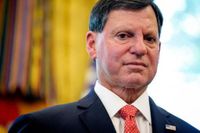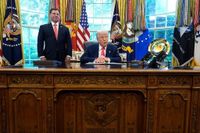In a move that has sent ripples through Washington and the broader federal workforce, Treasury Secretary Scott Bessent announced on October 6, 2025, that Frank Bisignano, the current commissioner of the Social Security Administration (SSA), will take on a second, unprecedented role as Chief Executive Officer of the Internal Revenue Service (IRS). The appointment, which creates a new executive position at the IRS, comes amid ongoing turbulence at the tax agency and a federal government shutdown that threatens to further disrupt essential public services.
According to a statement released by the Treasury Department, Bisignano will oversee all daily operations at the IRS while continuing to serve as SSA commissioner. He will report directly to Bessent, who remains the acting commissioner of the IRS—a dual structure that is itself a departure from tradition. The announcement follows several months of leadership instability at the IRS, including the abrupt resignation of former commissioner Billy Long in August after just two months on the job. Long, a former auctioneer and congressman, had been confirmed by the Senate in June despite criticism over his lack of experience in tax law or accounting, as reported by The Wall Street Journal and Reuters.
For Bisignano, this marks a significant expansion of his responsibilities. The former Wall Street executive and CEO of Fiserv, a major payments and financial services firm, was nominated by President Donald Trump to lead the SSA in December 2024 and confirmed by the Senate in May 2025. His career spans key leadership roles at JPMorgan Chase, Citigroup, First Data, and Fiserv, where he was credited with transformative growth and operational excellence. According to Bloomberg, Bisignano led First Data through its 2015 initial public offering and later oversaw its $22 billion acquisition by Fiserv, where he became CEO in 2020 and chairman in 2022.
Bessent praised Bisignano’s track record, stating, “Frank is a businessman with an exceptional track record of driving growth and efficiency in the private and now public sector. Under his leadership at the SSA, he has already made important and substantial progress, and we are pleased that he will bring this expertise to the IRS as we sharpen our focus on collections, privacy, and customer service in order to deliver better outcomes for hardworking Americans.” The Treasury secretary emphasized the shared technological and customer service goals of the IRS and SSA, calling Bisignano’s dual appointment a “natural choice.”
Yet, the decision has not been without controversy. Social Security advocates have voiced concerns about the potential for a leadership vacuum at the SSA, especially after the Trump administration’s workforce reductions earlier this year. Nancy Altman, president of Social Security Works, wrote, “Never in Social Security’s 90-year history has a commissioner held a second job. Bisignano’s new role will leave a leadership vacuum at the top of the agency, especially since the Republican Senate hasn’t even confirmed a deputy commissioner.” Max Richtman, CEO of the National Committee to Preserve Social Security and Medicare, added, “Seniors, people with disabilities and their families deserve a full-time Social Security Commissioner. Full stop.”
The Treasury Department has not directly addressed these concerns, but Bessent reiterated his confidence in Bisignano’s ability to manage both agencies. An SSA spokesperson told the Washington Examiner, “Secretary Bessent’s selection of Commissioner Bisignano to also lead the IRS speaks to the incredible customer service turnaround that is happening at SSA. In just five months since his confirmation, SSA is serving more customers efficiently and accurately due to technology and process management improvements. In his new role, Commissioner Bisignano will still lead SSA, along with the incredibly talented executive leadership team he has assembled since his Senate confirmation.”
Adding to the complexity, Bisignano’s appointment as IRS CEO circumvents the Senate confirmation process, a move made possible by the newly created position. This allows the Trump administration to quickly install a trusted appointee at the helm of the IRS without the delays or political wrangling that often accompany Senate hearings. As The Wall Street Journal points out, this strategy has raised eyebrows, particularly given the sensitive nature of the data handled by both the IRS and SSA. Privacy advocates have expressed unease about the potential for data-sharing or conflicts of interest between the two agencies, though no specific incidents have been cited to date.
The timing of the leadership shakeup could hardly be more fraught. The federal government shutdown, now entering its second week, has already curtailed services at multiple agencies. The IRS, which continues to process returns and payments as an essential service, faces the prospect of furloughing up to 35,000 employees—about half its critical workforce—if the impasse in Congress persists beyond five business days, according to Bloomberg and Newsweek. The SSA, meanwhile, remains open with contingency staffing plans to ensure that Social Security payments continue. Still, both agencies are operating under the cloud of uncertainty, with further disruptions possible if lawmakers fail to reach a budget agreement soon.
Bisignano’s dual appointment also comes on the heels of significant staff reductions at both the IRS and SSA under the Department of Government Efficiency (DOGE), which has pushed for leaner federal agencies. Earlier this year, the IRS let go more than 6,000 employees during tax season, further straining its capacity to serve the public. With the shutdown ongoing, the risk of additional layoffs looms large, and the effectiveness of Bisignano’s leadership may not be fully apparent until normal operations resume.
Observers from across the political spectrum are watching closely. Supporters of the administration argue that Bisignano’s private sector expertise is exactly what’s needed to modernize two of the government’s most public-facing agencies. They point to his success in driving efficiency and customer service improvements at Fiserv and, more recently, the SSA. Critics, however, worry that consolidating leadership in one individual could dilute accountability and weaken oversight, particularly at a time when both agencies face mounting challenges—from processing backlogs to cybersecurity threats and the ongoing demands of serving millions of Americans.
Meanwhile, the broader context of federal agency leadership is shifting. On the same day as Bisignano’s appointment, Verizon Communications named Dan Schulman, the former head of PayPal, as its new chief executive, underscoring a trend of private-sector leaders stepping into major public and corporate roles. While Schulman’s move is unrelated, it highlights the increasing value placed on operational experience and technological acumen in both government and business.
For now, the future of the IRS and SSA rests in Bisignano’s hands—and by extension, in the ability of the federal government to navigate an era of fiscal constraint, political polarization, and rising public expectations. Whether his dual stewardship will mark a turning point for these agencies, or simply add another layer of complexity to their already daunting missions, remains to be seen. One thing is clear: the stakes for millions of Americans could not be higher.
As Washington waits for an end to the shutdown and for signs of stability at the IRS and SSA, all eyes are on Frank Bisignano and the leadership team he must now guide through one of the most turbulent periods in recent federal history.


